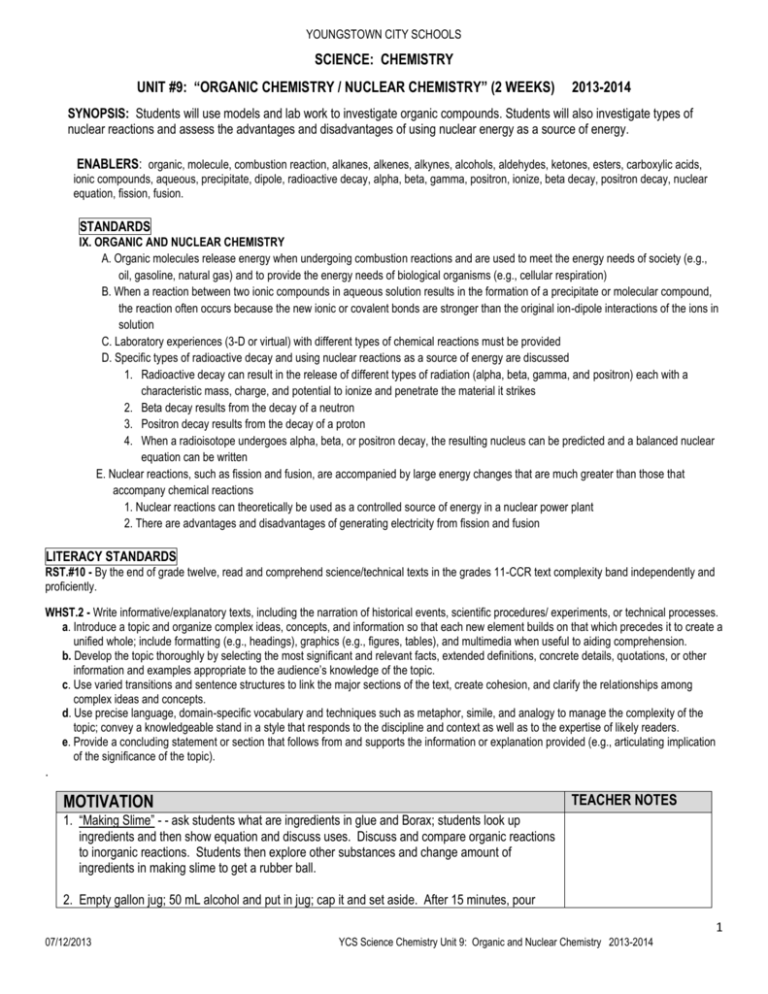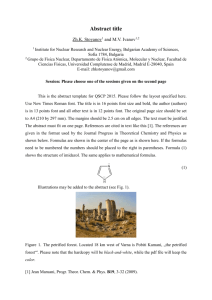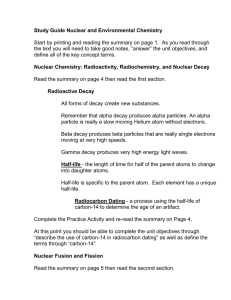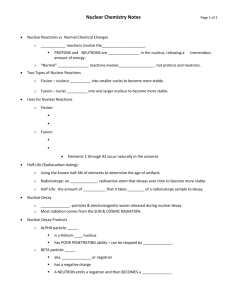Unit 9 - Youngstown City Schools
advertisement

YOUNGSTOWN CITY SCHOOLS SCIENCE: CHEMISTRY UNIT #9: “ORGANIC CHEMISTRY / NUCLEAR CHEMISTRY” (2 WEEKS) 2013-2014 SYNOPSIS: Students will use models and lab work to investigate organic compounds. Students will also investigate types of nuclear reactions and assess the advantages and disadvantages of using nuclear energy as a source of energy. ENABLERS: organic, molecule, combustion reaction, alkanes, alkenes, alkynes, alcohols, aldehydes, ketones, esters, carboxylic acids, ionic compounds, aqueous, precipitate, dipole, radioactive decay, alpha, beta, gamma, positron, ionize, beta decay, positron decay, nuclear equation, fission, fusion. STANDARDS IX. ORGANIC AND NUCLEAR CHEMISTRY A. Organic molecules release energy when undergoing combustion reactions and are used to meet the energy needs of society (e.g., oil, gasoline, natural gas) and to provide the energy needs of biological organisms (e.g., cellular respiration) B. When a reaction between two ionic compounds in aqueous solution results in the formation of a precipitate or molecular compound, the reaction often occurs because the new ionic or covalent bonds are stronger than the original ion-dipole interactions of the ions in solution C. Laboratory experiences (3-D or virtual) with different types of chemical reactions must be provided D. Specific types of radioactive decay and using nuclear reactions as a source of energy are discussed 1. Radioactive decay can result in the release of different types of radiation (alpha, beta, gamma, and positron) each with a characteristic mass, charge, and potential to ionize and penetrate the material it strikes 2. Beta decay results from the decay of a neutron 3. Positron decay results from the decay of a proton 4. When a radioisotope undergoes alpha, beta, or positron decay, the resulting nucleus can be predicted and a balanced nuclear equation can be written E. Nuclear reactions, such as fission and fusion, are accompanied by large energy changes that are much greater than those that accompany chemical reactions 1. Nuclear reactions can theoretically be used as a controlled source of energy in a nuclear power plant 2. There are advantages and disadvantages of generating electricity from fission and fusion LITERACY STANDARDS RST.#10 - By the end of grade twelve, read and comprehend science/technical texts in the grades 11-CCR text complexity band independently and proficiently. WHST.2 - Write informative/explanatory texts, including the narration of historical events, scientific procedures/ experiments, or technical processes. a. Introduce a topic and organize complex ideas, concepts, and information so that each new element builds on that which precedes it to create a unified whole; include formatting (e.g., headings), graphics (e.g., figures, tables), and multimedia when useful to aiding comprehension. b. Develop the topic thoroughly by selecting the most significant and relevant facts, extended definitions, concrete details, quotations, or other information and examples appropriate to the audience’s knowledge of the topic. c. Use varied transitions and sentence structures to link the major sections of the text, create cohesion, and clarify the relationships among complex ideas and concepts. d. Use precise language, domain-specific vocabulary and techniques such as metaphor, simile, and analogy to manage the complexity of the topic; convey a knowledgeable stand in a style that responds to the discipline and context as well as to the expertise of likely readers. e. Provide a concluding statement or section that follows from and supports the information or explanation provided (e.g., articulating implication of the significance of the topic). . TEACHER NOTES MOTIVATION 1. “Making Slime” - - ask students what are ingredients in glue and Borax; students look up ingredients and then show equation and discuss uses. Discuss and compare organic reactions to inorganic reactions. Students then explore other substances and change amount of ingredients in making slime to get a rubber ball. 2. Empty gallon jug; 50 mL alcohol and put in jug; cap it and set aside. After 15 minutes, pour 1 07/12/2013 YCS Science Chemistry Unit 9: Organic and Nuclear Chemistry 2013-2014 TEACHER NOTES MOTIVATION liquid out, then have students ignite the jug. Swish sound, pass container around and it feels warm; fumes are what ignites and blows-up. (IXA) 3. Preview that students will be writing informational paper for this unit. Discuss what they will have to do (Nuclear Chemistry) 4. Students set personal and academic goals 5. Preview the Authentic Assessment so students know what is expected by the end of the Unit TEACHER NOTES TEACHING-LEARNING 1. Teacher introduces organic molecules: one leads to the next group and shows how subgroups are formed: students build examples of each using the Molecular Model Kits (IXA1) a. Alkanes (first 10) b. Alkenes and Alkynes c. Alcohol d. Aldehyde and Ketones e. Carboxylic Acids f. Esters 2a. Lab: Distillation of alcohol (See Tim Bakos); students see how to separate substances through distillation. Proof and percentages of drinking alcohol (purify water). A proof is double the percentage; students research the idea of alcohol proof; sea water distillation; other types of distillation. (IXB, IXC) 2b. Lab: Analyzing Concentration of Acid (see Tim Bakos) teacher introduces and has students compare generic brands to name brands for concentration. Use aspirin for this activity. 2c. Lab: The Esters: taking alcohol, mix with organic acid and neat it, which will yield a smell (wintergreen, apple, cherry, banana, grape, root beer, etc.); connect the process to how candy flavors are made, scented candles, etc. Information found at: http://embracechallenge.net/chemistry/Chabot_June_20_2006/labs/Labsmisc/Esters_Chabotdou 1. Nuclear Chemistry: Nuclear Equations: Teacher shows practice problems that illustrate half-life and absorptions (alpha, beta, positron (how this works - - fusion reactions), neutron and how this works, and gamma) Nuclear Chemistry: Teacher demonstrates chain reactions; class discusses how this relates to nuclear reactors, submarines (Navy recruiter to talk to students), power plants, medicine (injecting radioactive iodine to show thyroid problems, nuclear stress test, etc.) industry (steel), cement, etc. (IXD, IXE) Virtual General Chemistry Labs: Click on Nuclear Chemistry; labs show in left menu http://www.uccs.edu/~faculty/danderso/vgcl/index.html; #2: Types of Radiation; #4: Radiation vs Distance; #5: Radiocarbon Dating. Relate the concepts to events happening today (e.g., Japan Earthquake, North Korea threat, etc.) The informational paper for the Authentic Assessment will come out of this research. TRADITIONAL ASSESSMENT TEACHER NOTES 1. Unit Test: Multiple-Choice TEACHER ASSESSMENT TEACHER NOTES 2 07/12/2013 YCS Science Chemistry Unit 9: Organic and Nuclear Chemistry 2013-2014 1. Lab reports or practical reports, using rubrics for quality points. 2. Assignments/worksheets 3. 2- 4-point questions TEACHER NOTES AUTHENTIC ASSESSMENT 1. Students evaluate their goals for the Unit. 2. Students build a model of an organic compound, research into what it is used for, how it is manufactured, the names, etc. 3. Students research some aspect of Nuclear Chemistry and write an informational paper. 3 07/12/2013 YCS Science Chemistry Unit 9: Organic and Nuclear Chemistry 2013-2014






